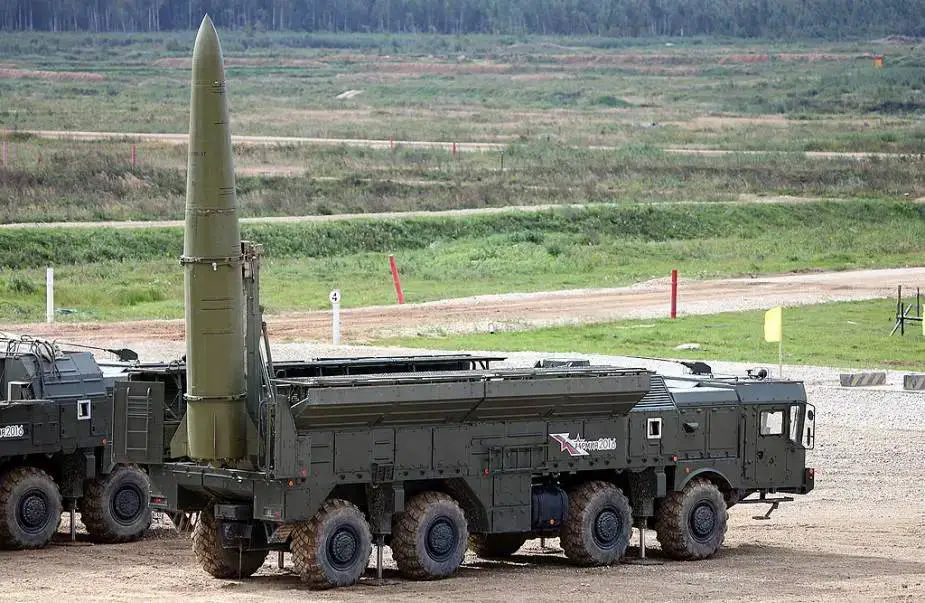Analysis: Russia to deploy tactical nuclear weapons in Belarus. When?
Russian President Vladimir Putin said on Saturday 25 March that Moscow would deploy tactical nuclear weapons on the territory of its ally, Belarus, a country located at the gates of the European Union.
Follow Army Recognition on Google News at this link

An alternate weapon to air-launched tactical nuclear missiles announced by Russian President Putin as to be deployed in Belarus: 9P78-1 TEL (Transporter, Erector and Launcher) of 9K720 Iskander-M SRBM system with 9M723K5 missile displayed at Armya 2016 defense forum near Kubinka. Iskander missiles can be armed with either a conventional or nuclear warhead (Picture source: Vitaly Kuzmin )
"There is nothing unusual here: the United States has been doing this for decades. It has been deploying its tactical nuclear weapons on the territory of its allies for a long time," Vladimir Putin said in an interview broadcast on a Russian television network. "We agreed to do the same," he added. "We have already helped our Belarusian colleagues and equipped their planes (...). Ten planes are ready to use this type of weapon", continued Putin. "From April 3, we shall start training the crews. And on July 1, we will complete the construction of a special warehouse for tactical nuclear weapons on the territory of Belarus," he added. Let us notice that such facilities in the nearby Kaliningrad have been under construction for seven years.
In fact, the United States does not have nuclear weapons deployed in a European or Asian country bordering Russia, the opposite of what Russia will do when (if?) deploying its nukes in Belarus which borders Poland, Lithuania and Latvia, all EU and NATO countries.
According to Putin, this decision was motivated by London's intention to send depleted uranium munitions to Ukraine. Putin threatened to also use this type of shell if Kyiv were to receive it: "Russia, of course, has something to answer for. We have, without exaggeration, hundreds of thousands of such shells. We are not using them at the moment". These armor-piercing shells produce toxic waste but have nothing to do with nuclear fission, Edward Lucas comments in cepa.org. So, their use by the Ukrainian army cannot, in any way, constitute a valid argument to deploy nuclear weapons in Belarus.
Ukraine and its Western allies have condemned Putin’s allegations and accused Russia of nuclear escalation. The UE is threatening Belarus with a new batch of sanctions, should it actually - and imprudently - shelter Russian nuclear weapons on its territory. Putin believes that everything that has happened since 1991 is a nightmare for Russia. He is busy restoring the situation that prevailed before the dissolution of the Union of Soviet Socialist Republics (USSR). When there were Soviet nuclear weapons on the territory of Belarus. In the logic of East/West confrontation, we see a return to a situation similar to the Euromissile crisis.
Russia suspended last month the important New START nuclear disarmament treaty signed with the United States, although it promised to respect the limitation of its nuclear arsenal until the effective end of this agreement on 5 February 2026. The Kremlin regularly rehearses the deployment of parts of its 2,000-strong stockpile of short-range nuclear weapons in western Russia.
Russia has taken Belarus as a "nuclear hostage", Ukraine said on Sunday, March 26, following the announcement by President Putin of the deployment of tactical nuclear weapons in Belarus which celebrated the 105th anniversary of their brief period of statehood following the 1st World War. Vladimir Poutine said, on Saturday, March 25, to have had the agreement of Minsk to deploy tactical nuclear weapons in Belarus. Whether the autocrat in Minsk actually wanted the weapons or not is irrelevant, Edward Lucas comments. Their promised deployment underlines Russia’s increasing grip on its smaller western neighbor whose president remains in place only thanks to Russia’s military support.
“The Kremlin has taken Belarus as a nuclear hostage,” Ukrainian Security Council Secretary Oleksiy Danilov wrote on Twitter, adding that this decision is a “step towards the internal destabilization of this country”. Indeed, if Belarus does not take a direct part in the conflict in Ukraine, Moscow used its territory to lead its offensive on Kyiv last year or to carry out strikes.
Interestingly, the announced deployment of Russian nuclear weapons in Belarus shows the limits of China’s repeated attempts to curb Russia’s nuclear saber-rattling, Edward Lucas underlines. Only days earlier, during Xi Jinping’s visit to Moscow, the Chinese and Russian leaders signed a joint statement saying that nuclear powers should not station their weapons beyond their borders and, indeed, should remove any such systems previously deployed. That was a clear dig at the United States, which maintains around half its arsenal of 200 non-strategic nuclear weapons in Germany, the Netherlands, Belgium, Italy, and Turkey, but not in a country bordering Russia.
So, Vladimir Putin is about to already breach the brand new rule agreed upon with its Chinese ally. It also breaches the Treaty on the Non-Proliferation of Nuclear Weapon: the US weapons in Europe are exempt from its provisions because they were already deployed before it came into force in 1970.
Yet Putin’s failing war in Ukraine spells new hope for Belarus, Edward Lucas writes: Russian imperialism and militarism have crystallized and consolidated feelings of national identity in Belarus as well as Ukraine. Any attempt to use the Belarusian military against Ukraine risks mutiny or desertion while volunteer Belarusians are already fighting on Ukraine’s side, Edward Lucas comments in the wave of many other analysts. A defeat for Russia would leave Lukashenko without his only protector.
Defense News March 2023


























